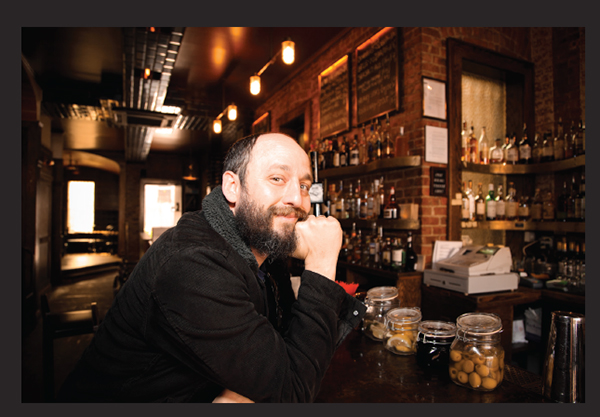

A Portrait Artist Attempts to Build Community at the Crown Inn
Rusty Zimmerman already anticipates the cynical view you might have about the Crown Inn. It’s “one of the early emblematic symbols of, ‘Here comes change,’” he says of the nearly four-year-old bar in Crown Heights, the famously Jewish and black Brooklyn neighborhood that’s also in the grip of gentrification.
What’s less complicated is the role this watering hole plays for this thirty-five-year-old professional portrait artist who moved to New York in 2005. He pops into the Crown Inn a couple times a week. His friends and neighbors bartend here—“the faces you see on the block,” he calls them. He’ll walk through the doorway, past the wide picture window that looks out to the block and all those faces. He’ll hug five people at the bar, give “copious high fives,” and catch up. It’s “the quintessence of bullshitting,” he says. “Not having anything terribly important to discuss. It’s just the ease and familiarity with which you can break down your day-to-day.”
That easygoing demeanor plays opposite to his ambitious portrait project. With his Free Portrait Project, Zimmerman is in the midst of painting two hundred expertly made portraits of the people of Crown Heights and giving them those beautiful portraits for free. He aims to “paint a picture of who we are now amid shifting demographics and thus upturn the tradition of portraiture reserved only for a wealthy few by giving portraits to all walks of life.” If that sounds rehearsed, that’s because it is. I caught up with Zimmerman in the middle of a long day of fund-raising, something he’s doing, he said, thirteen hours a day, seven days a week: “My lady misses me. She doesn’t hesitate to say so.” We talked about the project, bringing his adopted community together in the midst of so much change, and the beauty of a cheap beer.

It’s kind of a living room. Like the places you pass through on your way to bed. Friendly faces abound. Pedro here, gentleman in the baseball cap, we became friends from here in the neighborhood. He absolutely delights that I speak Spanish. [I lived for] seven weeks in a rural town in Mexico when I was a kid, a ranch town where nobody spoke English, and also working in kitchens. I’ve been cooking since I was fifteen.
It started with people sitting on my couch when my studio was in my house. It was me in a chair and them in a couch. It mirrored a traditional therapeutic environment. People told their life history: pain of recent breakups, disappointment from childhood. From “Wish my dad came to my soccer game” to “I remember getting drunk with a girl and making out in college.”
The idea is to have a number of receptions throughout the year. When a batch of ten or twenty of these paintings is done, we have a reception. We notify all the people who sat through the portrait. We say you’re going to be on a wall, and you can come for food and wine. You can leave it to chance or just shuffle. You can include some Hassids, some West Indians, some hipsters. It physically draws people together under one roof. You think, “Oh, I was just going to see my people.” Then the light switch clicks and you say, “Oh, these are my people, too.”

I don’t have any particular religious affiliation. I just try to be good, of use.
It’s like, “Here comes another Brooklyn bar.”
I got called into a minyan the other day. It’s a Jewish rite of burying the dead. They said this woman, her mother passed away, we need a quorum of ten people to pray and say amen so that we can put her mother to rest. “We got nine guys, and we need one more. Can you come in for half an hour with the Hebrew reading, say amen, and then afterwards we’ll have matzo and wine?” They invited me back. They said, “Every other week we have free-range pastrami.” Whether or not the ritual means anything to me, that’s a technicality. If it helps this woman put her mother to rest, then it’s what the Jews call a mitzvah. It’s what you do.
I enjoy all kinds of beverages. Anything that falls down dead in front of me. It’s me being accommodating and easygoing.
It’s like, “Here comes another Brooklyn bar made of reclaimed wood and subway tile and Edison light bulbs and steel,” that which was followed by so many replicas. So, it’s complicated.
There’s only so much you can do to address income inequality. I can’t take my landlady out for $11 soup because she is going to have cheaper soup elsewhere and not give it a go. What I can do is in the work I’m doing. Forcefully put people in the same room and promote a sense of engagement and instill a sense of commonality. To say you are a Hasidic Jewish man and your face is on the wall painted next to mine—somehow we represent Crown Heights in transition. Then you say, “Oh, hi, my name is Rob,” and he says, “Oh, my name is Chaim.” And then all of a sudden, people have something to talk about.
These are my people, too.
The more they talk to each other, the more they take care of each other.
I say hi to everyone. There’s this universal nod, and “hello.” It’s the one word “alright.” To which you say, “Alright.” And that’s it. If someone looks you askance, you don’t have to avert your eyes and move to the other side of the street to avoid confrontation. You say “alright” back and that’s that.
I have never bought a $14 jar of pickles. I fall into that stereotypical set of people who make their own pickles because it’s fun and cheaper.
April 21, 2015

(Photos by Phil Provencio)